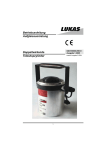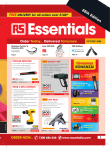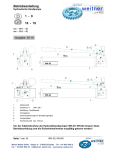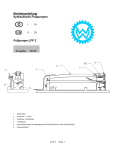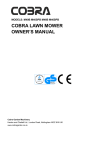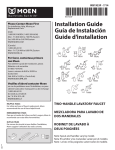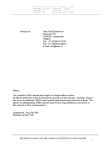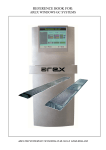Download Operating Instructions Rerailing Equipment Double
Transcript
Operating Instructions Rerailing Equipment 84072/0000-85N GB Issue 1.2005 Double-acting Telescopic Cylinders replaces issue 9.2004 1 Contents 1 2 3 4 5 6 7 8 9 10 11 12 13 14 15 Page Safety instructions 3 Organizational measures 3 General safety instructions 4 Instructions for maintenance and service 5 Function of individual components 5 5.1 General 5.2 Coupling connectors 5.3 Hoses between control desk and cylinders 5.4 Quick-connect couplers 5.4.1 Hose pair acc. to 84072/1765 5.4.2 Single hose, red 5.4.3 Connection of quick couplers Initial Commissioning 7 Installation 7 7.1 Safety notes 7.1.2 General instructions for the installation / operation of the cylinders 7.1.3 Note for retracting the cylinder Hydraulic connection and operation 8 8.1 General 8.1.1 Connection of telescopic cylinders 8.2 Operation of cylinders Zubehör 8 9.1 Base plates 9.1.1 Mounting the base plates 9.2 Stacking sets 9.2.1 Attributes of stacking sets 9.2.2 Installation / operation of the stacking sets Dismantling of components 9 Maintenance 9 11.1 Mechanical check 11.2 Hydraulic system leakage 11.3 Cylinder components 11.4 Oil recommendation Problems / trouble shooting 10 Repair 11 Hydraulic diagram 11 Technical data 12 2 1 Safety instructions Basic operation and designated use of the machine 1.1 The cylinders described below may only be used in combination with components from LUKAS rerailing equipment. It is possible to operate them with devices from other manufacturers -- however, this requires technical testing/approval by LUKAS in each individual case. 1.2 The machine is intended exclusively for driving and controlling rerailing equipments. Any other use, e.g. driving and controlling other hydraulic equipment, is not according to specifications. The manufacturer/supplier will not accept any liability for damage as a result thereof. The risk is entirely to be borne by the user. Use according to specifications also means that the operating instructions are observed and that the conditions for inspection and maintenance are to be met (see also chapters 4 and 13). 1.3 The machine has been built in accordance with state-of-the-art standards and the recognized safety rules. Nevertheless, its use may constitute a risk to life and limb of the user or of third parties, or cause damage to the machine and to other material property. 1.4 The machine must only be used in technically perfect condition in accordance with its designated use and the instructions set out in the operating manual, and only by safety-conscious persons who are fully aware of the risks involved in operating the machine. Any functional disorders, especially those affecting the safety of the machine/plant, should therefore be rectified immediately. 1.5 Device designation HP 25 T min. push capacity in tonnes high-pressure cylinder telescopic design - 450 R total stroke in mm hydraulic piston retraction 2 Organizational measures 2.1 The operating instructions must always be at hand at the place of use of the machine, e. g. by stowing them in the tool compartment or tool-box provided for such purpose. 2.2 In addition to the operating instructions, observe and instruct the user in all other generally applicable legal and other mandatory regulations relevant to accident prevention and environmental protection. This also applies for wearing protective clothing, helmet with visor or goggles and protective gloves. 2.3 In order to avoid injuries, the machine must only be operated by a specially trained operator who has undergone safety training. It is also important to consider the influence of stress factors on the operator when working at the machine. These may constitute a risk to life and limb of the user or of third parties, or cause damage to the machine and to other material property. 2.4 Observe all safety instructions and warnings attached to the machine. Make sure that safety instructions and warnings attached to the machine are always complete and perfectly legible. 2.5 Never make any modifications, additions or conversions which might affect safety without the supplier’s approval. This also applies to the installation and adjustment of safety devices and valves as well as to welding work on load-bearing elements. 3 2.6 Spare parts must comply with the technical requirements specified by the manufacturer. Spare parts from original equipment manufacturers can be relied to do so. It is only allowed to use original LUKAS spare parts or LUKAS system components. 2.7 Replace hydraulic hoses within stipulated and appropriate intervals even if no safety-relevant defects have been detected. This has to be done after 10 years at the latest. 2.8 Adhere to prescribed intervals or those specified in the operating instructions for routine checks and inspections. 2.9 Make sure to dispose properly of packing material and dismounted parts! 3 General safety instructions 3.1 Check all parts for possible damage before starting up. 3.2 When operating the machine, pay attention to the ambient conditions, making sure that you wear suitable personal protective clothing. Also pay attention to the fact that the cylinders could heat up after a while. They may also cool down considerably depending on the ambient conditions. This must likewise be borne in mind by wearing suitable protective clothing. 3.3 Also be aware that possible noise could result from various sources during operation which may impede communication. During operation, there may also be impairment from exhaust fumes. Make sure that there is sufficient ventilation or that protective measures are taken. Since the cylinders are coupled with hose pipes, they may constitute a tripping risk. Ensure that the hose pipes are safely installed. This is especially important due to the fact that escape routes must be provided. 3.4 When working, make sure there is sufficient lighting and a clear view of the machine, so as to guarantee safe working conditions. 3.5 Before switching on/starting up and while operating the machine, please ensure that nobody will be endangered when the machine starts running. Also, secure the machine against unauthorised or accidental switching on/off. 3.6 In the event of malfunctions, stop the machine immediately and lock it. Have any defects rectified immediately. 3.7 Before setting the machine in motion always check that the accessories have been safely stowed away! During transport, the weight of the LUKAS telescopic cylinders must be taken into account. 3.8 Avoid any operation that might be a risk to machine stability! For this reason, a base plate (refer to chapter 9.1) must be used. Also check that the foundation has sufficient load-bearing capacity. 3.9 Check the machine at least after every operation for obvious damage and defects. Report any changes (incl. changes in the machine’s working behaviour) to the competent organization/person immediately. If necessary, stop the machine immediately and lock it. All lines, hoses and screwed connections have to be checked for leaks and obvious damage. Repair damage immediately. Splashed oil may cause injury and fire. 3.10 All safety equipments have to be checked for completeness and flawless condition: - instruction markings and warning signs (safety instructions) - check safety cover (e.g. motor-safety covers, heat protection etc.) if they are available and if they are in a good condition. 4 3.11 Working under loads is not allowed if they are only lifted by hydraulic cylinders. If the work is indispensable sufficient mechanical supports are needed additionally. 3.12 Make sure that hoses are not mechanically stressed (pulling, bending etc.). 3.13 When working in the vicinity of live components and cables, it must be ensured that precautions are taken to avoid current conductions or high-voltage flashing over to the motor pump. 3.14 During use of cylinder unit, the creation of electrostatic charges which could result in sparking must be prevented. 3.15 When mounting the cylinders the power unit should always be placed in such a way that its function and safety will not be impaired by strong external temperature influences. 4 Instructions for maintenance and service 4.1 For the execution of maintenance and service work, tools and workshop equipment adapted to the task on hand are absolutely indispensable. Work on the hydraulic system must be carried out only by personnel having special knowledge and experience with hydraulic equipment. 4.2 Before putting into operation clean the machine, especially connections and threaded unions, of any traces of oil, fuel or preservatives before carrying out maintenance/repair. Never use aggressive detergents. Use lint-free cleaning rags and pay attention that the components are meticulously clean during reassembling after repair. 4.3 During dismantling of machines it is necessary to collect the outrunning hydraulic liquids completely, so that they cannot reach the ground. They have to be disposed properly according to the instructions. 4.4 Always tighten any screwed and thread connections that have been loosened during maintenance and repair. Observe the stipulated torques. 4.5 Aggressive material (acid, lye, solvent, vapour) can damage the machine. It is necessary to clean the whole machine if it must be exceptionally operated under such conditions or gets into touch with these materials. Additionally, the machine must be checked as described under 3.9. Please refer to our separate booklet "Safety instructions for hydraulic hoses" 84150/8065-85 (delivered with hose)! 5 Function of individual components 5.1 Gerneral LUKAS Telescopic cylinders are equipped with several pistons one fitting into the other among which the total stroke is divided. Characteristics: - Small overall size in relation to stroke. - Different lifting capacity in the individual stages due to different piston diameters. Please observe the max. lifting capacity of the different pistons with a view to the max. permissible load of support blocks used with the cylinder. This especially applies to the permissible load for shifting devices of LUKAS rerailing equipment. - Max. working pressure is 53 MPa (530 bar). 5 5.2 Coupling connectors Apart from the coupling connectors, these cylinder models are also provided with two connector blocks with a safety valve, thus preventing damage to the cylinder in the event of external loads. If pressure exceeds the maximum permissible value, the safety valve will open automatically, and oil will squirt out (protected). 5.3 Hoses between control desk and cylinders Those are normally connected via 10 m long hose pairs (red/blue, ref. 84072/1765). All hoses are duly colour marked and equipped with quick couplers in non-interchangeable design: - connection to A (= extension) red, - connection to R (= retraction) blue. 5.4 Quick-connect couplers 5.4.1 Hose pair red/blue 84072/1765 The hose couplings of this hose pair are equipped with a „quick-stop“ function which will block the oil reflow from the cylinder if, for example, a hose breaks, thus preventing the load from being dropped. When lowering a very heavy load or when switching the control valve to „lowering“ position too quickly, the quick-stop may catch without there being a necessity for it. Then the cylinder can no longer be retracted. In this case switch the selector valve to „lifting“ again until the cylinder starts to extend. Carefully start the lowering procedure again. 5.4.2 Single hose, red The quick-stop feature is optional for this hose. It requires the use of the StMu 61-M coupling sleeve (colour silver or yellow). 5.4.3 Connection of quick couplers - Remove dust protection covers. - Unlock connect socket with adjusting ring by turning it. - Retract sleeve and connect plug and socket while holding the sleeve in this position. - Release sleeve and lock adjusting ring: showglass is “RED”. The connection has now been made and secured. 6 Note regarding the modified release mechanism as of June 2004 When connecting the hoses, be aware of the following basic functions of the quick couplers: X Y Before coupling unlock the connect socket by turning the sleeve into position X. Retract sleeve and connect plug and socket. Release sleeve and turn it into position Y. Now the connection has been made and locked. Uncoupling is done in the reverse order. Connection of the hoses is possible only, when they are depressurized. In order to prevent contamination of the tool lines protect the couplings with delivered dust caps. Attention Quick-connect couplers partly have special functions. Therefore it is not allowed screwing off them from the hoses or to exchange them! To avoid pollution, the dust protection covers must be put on plug and socket if the couplings are not connected. The dust protection covers must be connected to each other if the couplings are connected. 6 Initial commissioning Prior to commissioning the cylinders must be vented ! - Extend pistons without load approximately halfway. - Turn cylinder upside down, the highest point of the cylinder must be lower than the the valve block on the power unit. - Extend pistons about twice by means of the corresponding valve so that air can escape from cylinder and hoses. 7 Installation 7.1 Safety notes 7.1.1 Prior to installation of the cylinder, the load to be lifted must be properly secured against rolling off in accordance with the applicable guidelines of the user’s country. Always observe the load while moving it by means of a cylinder! Do not stand below suspended loads. If in exceptional cases this cannot be avoided, these loads must mechanically be sufficiently secured against movement in any direction! 7.1.2 General instruction for the installation / operation of all cylinders - Put the cylinder on a level, non-slip surface, (Attention: hydraulic oils may cause slippery films on the ground!) - The area of support must be a continous level surface (not a grating, gravel, etc.). - Never put cylinders on a yielding support. - Never use cylinders without piston guard plate in order to avoid damaging the piston and to assure safe application of the force. - Always use wooden supports between the piston guard plate and the jacking point. - Always use LUKAS base plates (see accessories, chapter 9). - Observe centred load initiation on the pistons ! If necessary try to find a better load application point. 7 7.1.3 Note on retracting the cylinder The load may only be lowered with the pump running. Otherwise a vacuum could be created which would cause air to enter the hydraulic system. 8 Hydraulic connection and operation 8.1 General Prior to connecting the hoses carry out correct cylinder installation as per chapter 7. Make sure that the pump is switched off! 8.1.1 Connecting the telescopic cylinders As described in chapter 5.3, first connect the blue hose, then the red hose of the pair of hoses. 8.2 Operation of cylinders Operate the cylinders as per operating manual of the power unit delivered with the cylinders. 9 Accessories 9.1 Base plates Base plates are designed to: - enlarge the floor space of the cylinder, - increase static stability, - level out unevenness of the ground. 9.1.1 Mounting the base plates Put cylinder on the base plate in such a way that the coupling connector meshes with groove of the guide collar. Tighten the three srews on the guide collar. Now the cylinders can be carried together with the base plate. 9.2 Stacking sets 9.2.1 Attributes of stacking sets Multistage sets prolong the stroke of a cylinder. For space reasons, cylinders with large strokes often cannot be used due to their large overall height. Multistage sets make it possible to use cylinders with small overall height to lift loads very high. Generally multistage sets consist of: - cylinder attachments - piston attachments - piston protection plate - forked lever. 8 9.2.2 Installation / Operation of stacking sets - Lift the load with the cylinder using the normal piston guard plate. - Place the first stacking ring (item 7) centrally on the cylinder body by means of the forked lever. Caution under load! - Lower the load onto this stacking ring and retract the piston. - Remove the standard piston guard plate from the cylinder. Caution under load! (refer to chapter 7.1.1,). - Place the first piston plate (item 8) centrally onto the piston body (using a forked lever). - Completely extend the load again by means of the piston. - Insert the second stacking ring (item 9) by means of the forked lever. - Lower the load onto this stacking ring. - Insert the nose of the second piston platein the corresponding hole of the first plate (use fork lever!). - Completely lift the load by means of the piston. - Continue in this way... 10 Dismantling of components For dismantling of the components reverse the installation sequence. Before final dismantling of the devices it is absolutely necessary to ensure that: ——> the load is in a stable, immovable position, <—— ——> the drive motor/engine must be shut down, <—— ——> all hoses have been depressurized: <—— - Switch selector valve on the power unit temporarily to “LOWERING”(pressure relief of hoses), then switch back to the centre position. Disconnect the DEPRESSURIZED hoses in this order: : ——> hose, piston side red, ——> hose, rod side blue. 11 Maintenance 11.1 Mechanical check After each operating procedure the components must be checked for faultless operation (clean them first if necessary): - Check whether each single piston retracts smoothly (cylinders/pistons O.K.?), - Check whether there are any loose hydraulic screw connections on the devices and hoses; tighten them if necessary. - Check the mechanical parts, the valves and the hoses of power pack, control table and cylinders for mechanical damage. - Check whether the signs, warnings, operation and control symbols and other markings (colour markings) are complete and perfectly legible. - Check whether all safety covers (engine: protective cover, exhaust pipe cover), hoop guard etc. are available and in perfect condition. - Check the condition of the accessories (baseplates, header plates, etc.). 9 11.2 - Hydraulic system leakage Check devices for oil loss and replace defective seals if necessary. Important: Carry out the following procedures over an oilpan; dispose of used oil! 11.3 Cylinder components To remove the oil remaining in the piston main zone and piston ring zone, unscrew both couplings from the connecting blocks if necessary and wait until all of the oil drains. Then flush and fill up fresh hydraulic oil. Screw couplings in and tighten them to 45 Nm torque. Vent cylinders acc. to chapter 6! Remark: Please note that the oil filling must be completely flushed and replaced by another type of oil if there is a significant change in the operating conditions (ambient temperatures). Also refer to the following chapter. 11.4 Oil recommendation Oil for LUKAS hydraulic devices: Mineral oil in accordance with DIN 51524 and others A B C D E Range of oil temperature - 24 ... + 30 °C - 18 ... + 50 °C - 8 ... + 75 °C + 5 ... + 80 °C - 8 ... + 70 °C Viscosity rating HL 5 HLP 10 HLP 22 HLP 32 HF - E 15 Remarks biodegradable 2 recommended viscosity range: 10 ... 200 (mm /s). 12 Problems / Trouble shooting Index: P = Problem; S = Symptom; F: Cylinder pistons cannot be retracted S: red hose on the piston side is pressurized —> quick-stop has been activated; switch selector vlave to "lifting" for a moment and carefully start lowering again. P: Hose couplings cannot be connected S: red hose on the piston side is pressurized —> hoses are under pressure since they have accidentally been disconnected without being depressurized - open union nut on hose, cover against oil spray, - Hose is depressurized; pay attention to squirting oil, - tighten union nut again (MA = 45 Nm). 10 If the faults cannot be rectified, notify an authorized LUKAS dealer or LUKAS Customer Service direct at the following address: LUKAS Hydraulik GmbH, Weinstraße 39, 91058 Erlangen, Germany; P.O. Box 25 60, 91013 Erlangen, Germany; Customer Service tel.: +49 (0) 91 31/69 83 48; fax +49 (0) 91 31/69 83 53. 13 Repair In all system components only genuine LUKAS spare parts as listed in the spare parts list may be replaced, since for that purpose it is absolutely necessary to consider special tools, assembly notes, safety aspects and checks that might be required. See chapter 2.6 and 4 of Safety instructions. 14 Hydraulic Diagram 11 15 Technical data Order no. Permissible load Length, extended Total stroke Stroke piston 1/2/3 Lifting force piston 1 / 2 / 3 Required oil capacity Ambient temperature Dimensions dia. x height Weight Order no Permissible load Length, extended Total stroke Stroke piston 1/2 Lifting force piston 1 / 2 Required oil capacity Ambient temperature Dimensions dia. x height Weight HP10/T280R 84072/4665N 493 278 90 / 94 / 94 mm 650 / 301 / 104 kN 1.4 l HP25/T185R HP25/T450R 84072/1565N 84072/3765N 53 MPa (530 bar) 399 830 184 450 95 / 89 223 / 227 mm mm 650 / 301 650 / 266 kN kN 1.3 l HP50/T185R 84072/8265N 419 185 89 / 96 mm 1066 / 504 kN 2.8 l 2.0 l dia. 170 x 380 mm 23.8 kg dia. 220 x 234 mm 25 kg -20 ... +55 °C dia. 170 x 215 mm 14.8 kg dia. 170 x 215 mm 14.8 kg HP50/T400R HP65/T400R 84072/8065N 84072/1065N 53 MPa (530 bar) 799 797 399 397 195 / 204 198 / 199 mm mm 1066 / 504 1665 / 703 kN kN 4.3 l 7.0 l -20 ... +55 °C dia. 220 x 400 mm 41.6 kg dia. 270 x 400 mm 61.1 kg 12 © Copyright 2002 LUKAS Hydraulik GmbH LUKAS Hydraulik GmbH A Unit of IDEX Corporation Weinstraße 39, 91058 Erlangen • Germany Postfach 2560, 91013 Erlangen • Germany Telefon: +49(0)9131/698-0 • Telefax: +49(0)9131/698-394 e-mail: [email protected] Tel_Zyl_LAA_Ag105_e.P65 13 Subject to revision













